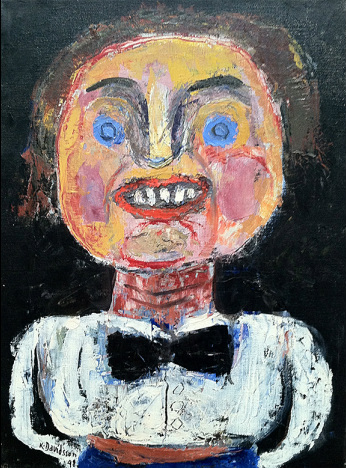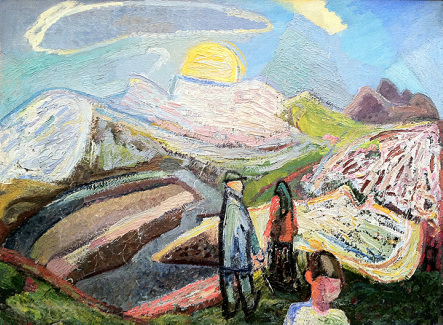Confronting Nature
Reykjavik, Iceland
"The first great consideration is that life goes on in an environment; not merely in it but because of it, through interaction with it." --John Dewey (2)
|
It is as though the jaggedness and discontinuity of Icelandic reality required Modernism to do artistic justice to itself—which explains why Iceland celebrates its modernists, who have worked abroad to find ways of bringing to visual consciousness the lived experience of being there. -- Arthur C. Danto (1)
From the book Confronting Nature: Icelandic Art of the 20th Century edited by Arthur C. Danto, Emertius Professor of Philosophy, Columbia University Reykjavik Art Museum: Kjarvalsstdair
The images (photographs that I took while viewing the exhibit) in the slideshow on the right are from the overview of Icelandic art that was on exhibit while I was in Reykjavik. It couldn't have been better timed if I had planned it that way. The exhibit gave me an opportunity to learn about the art of Iceland through the 20th Century. In the book quoted above, which is not the exhibit catalog but a separate project done in 2001, that until 1904 when Iceland became home ruled, art was primarily folk and textile based. Icelandic Modern art began with the first art exhibition by Thórarinn B Thorláksson in 1900. He painted landscapes which launched landscape painting as the basis of a national art celebrating their independence from Denmark which was achieved in 1944. (1)
In choosing images to photograph I tried to focus on scenes depicting ordinary moments, which is a theme in my own art and an essential element in John Dewey's philosophy regarding art as experience. Direct experience comes from nature and man interacting with each other. In this interaction, human energy gathers, is released, dammed up, frustrated and victorious. There are rhythmic beats of want and fulfillment, pulses of doing and being withheld from doing. -- John Dewey (2) Before arriving in Iceland, and knowing nothing about the country, its people, and especially its art, I tried to visualize what I thought the art would be like. Since Iceland is an Island, smaller than Colorado, I thought sea and fishing themes would be prevalent--I was wrong. I thought there would be a strong emphasis of land and that people would have a subordinate place next to the immensity of the geology. In this case I found much to support this preconception in this show. I also had the impression of a strong spiritual sense associated with the land, but very little organized religious influence. I also thought there would be more motifs that came from folk influences common in their textiles and traditional clothing designs. In this show I found almost nothing of that nature. In fact the only place that I saw that was in the shops. That doesn't mean it doesn't exist, I just didn't see it in my limited time in Iceland. It has been claimed the forces of nature are closer, more all-embracing, even overwhelming for people in Iceland than in other countries. Icelandic nature is not only a challenge for all the senses, it is also part of the national consciousness, and from it Icelanders derive part of their identity. 1. Kvaran, D. O. (2001). Confronting nature: Icelandic art of the 20th century. Reykjavik: National Gallery of of Iceland. 2. Dewey, J. (2005). Art as experience. New York, NY: Perigee |
Icelandic Art 1900-1950: From Landscapes to Abstract Art
Since 1900 when Thórarinn B. Thorláksson presented his work in Reykjavik’s first art exhibition, Icelandic artists have carried on a dialogue with European and later with American art, into which they have inserted the experience that is uniquely theirs, that of living on the planet’s youngest and most geologically active land mass. -- Arthur C. Danto (1)
They have an independence born of centuries of withstanding devastating catastrophe, Icelanders know who they are, not just in terms of genealogy, but in terms of a collective history, including daily reminders of geological history , and most of all in terms of the shared experience of living at the outer limits of human habitation. -- Martica Sawin (1) It has been claimed the forces of nature are closer, more all-embracing, even overwhelming for people in Iceland than in other countries. Icelandic nature is not only a challenge for all the senses, it is also part of the national consciousness, and from it Icelanders derive part of their identity. -- Audur Ólafsdóttir (1) The nature of the north is used, according to Eliasson, “like a medium to stir the spectator’s consciousness and prompt him to think about his experiences.” Only in this way can we be made to look at ourselves and our own environment in the eye. -- Audur Ólafsdóttir (1) | ||||||||||||||||||||

